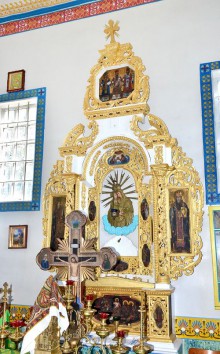Khoriv is a small village, with just 70 homesteads and less than 400 inhabitants. It is connected to Lokachi, from which it is only a few kilometers away, not by a road, which is half-ruined, but by a mere direction running between fields and hills. However, there are plenty of well-built houses and reach homesteads there, and the local St. Onuphrius Church is well-maintained and colorful like an Easter egg. The shrine has preserved its original appearance, it has never been rebuilt or had any additions built, and since its consecration in 1870, it has never been closed. Having survived the First and Second World Wars, it was one of the six churches in the raion where the mass was celebrated even under the militant atheist regime.
The little church’s interior astounds the viewer with its color scheme and the quality and amount of work invested in it all. It includes unusual malachite-like panels which the parish priest, Father Yakiv Muliar, spied out in a certain Volyn church as he traveled a lot looking for details that would make his shrine unlike any other. It also includes wall paintings, in particular, a copy of The Kyivan Caves Image of the Virgin Mary with the Saints Anthony and Theodosius of the Caves, which is placed above the iconostasis: definitely, no near or distant church has anything like that. In general, these wall paintings and all the interior decoration with its ornaments of amazing beauty serve to confirm that faith brings the joy of the Resurrection. While the village of Khoriv was small, it still invited the best artists to work on the church: in particular, Ihor Ivashko from Horokhiv, who studied under the great Oleksandr Koretsky. Some paintings were done by parish priest of the Mervyn Church (Berestechko Deanery of the Volyn Diocese of the Ukrainian Orthodox Church) Father Pavlo Klitsuk, who was Father Yakiv’s classmate at the theological seminary.
The little Khoriv Church is a rare case of organic unity between the modernity and the antiquity. Repairs were made, but the old wooden windows were not discarded, and they look organic beside the old walls. Father Yakiv has not allowed the old icons that have come down to him in the authentic form to be repainted or have new images added. Unfortunately, a lot of them had been already repainted by unknown persons, at unknown times, and for unclear purposes. The iconostasis was the first victim of it, which should have been an interesting work in such an ancient church. The priest says that at present, his lowly rural parish cannot afford to finance restoration of the iconostasis, although it would be highly desirable to see which faces of saints are hidden under the ancient layers of paint. After all, this iconostasis came here from another Khoriv church which has long been destroyed, and it was older than the St. Onuphrius Church...
The Khoriv shrine has its own relic: the altarpiece painted by Iov Kondzelevych, the icon painter who is seen as the most prominent figure in the history of Ukrainian painting of the 17th and 18th centuries. Since the altarpiece is located behind the altar, women can only see it from a distance, like I did together with Tetiana Yelisieieva, the head of the Volyn Icon Museum, while staying in Khoriv. However, there are descriptions made by the museum’s specialists, there are photos of each border scene from the iconostasis. “Initially, the altarpiece was intended for an icon of St. Nicholas, as evidenced by the image of the Nicean miracle in a big border scene over the icon: the Virgin Mary and Jesus Christ hold up not only an omophorion and a Gospel, but also a miter which they crown the central image with,” said Yelisieieva. “The scenes from the saint’s life include The Baptism of St. Nicholas, The Apparition to Emperor Constantine, The Apparition to Three Men in Prison, and The Burial of St. Nicholas. Another border scene depicts the apparition of Christ to St. Peter of Alexandria, whose image we can see in a border scene on the inner frame of the altarpiece.”
But most importantly, the altarpiece is paired with another one made for the miraculous icon of the Virgin Mary at the Church of the Nativity of the Virgin in the Zahoriv Monastery in Volyn (now this second part is kept in a museum in Lviv). It is a pity that images in some border scenes of the Khoriv altar iconostasis were also painted-over by later ‘masters.’ Therefore, on the one hand, it is a pity that this unique 17th century piece is housed in a lowly, so to speak, rural church. Any museum, Yelisieieva believes, would be honored to get this iconostasis and display it. Such pieces are the property of the state in Ukraine, they are registered, they are owned by the Ukrainian nation, and not individual museums. In Western countries, such pieces are removed from shrines by government order and transferred to museums, for they are monuments of spiritual culture and history of art. Experts believe that the Khoriv “diamond” needs to be restored, and the rural church should perhaps even have another iconostasis, a new one donated to it as a replacement. However, our government usually has no time for such projects.








